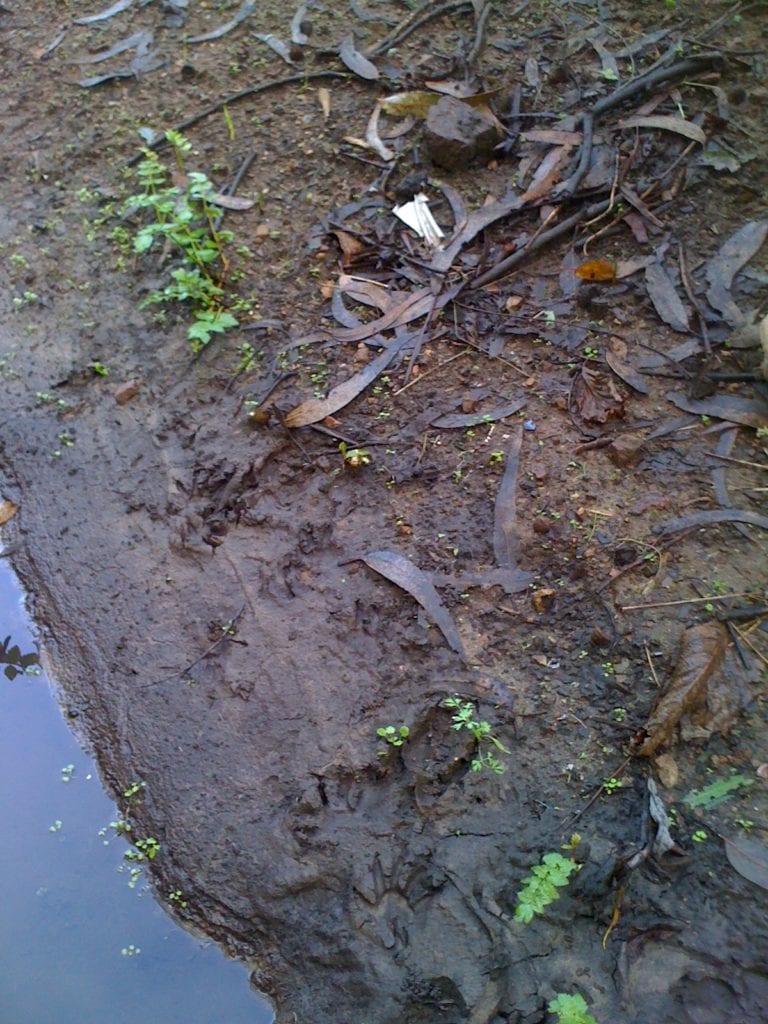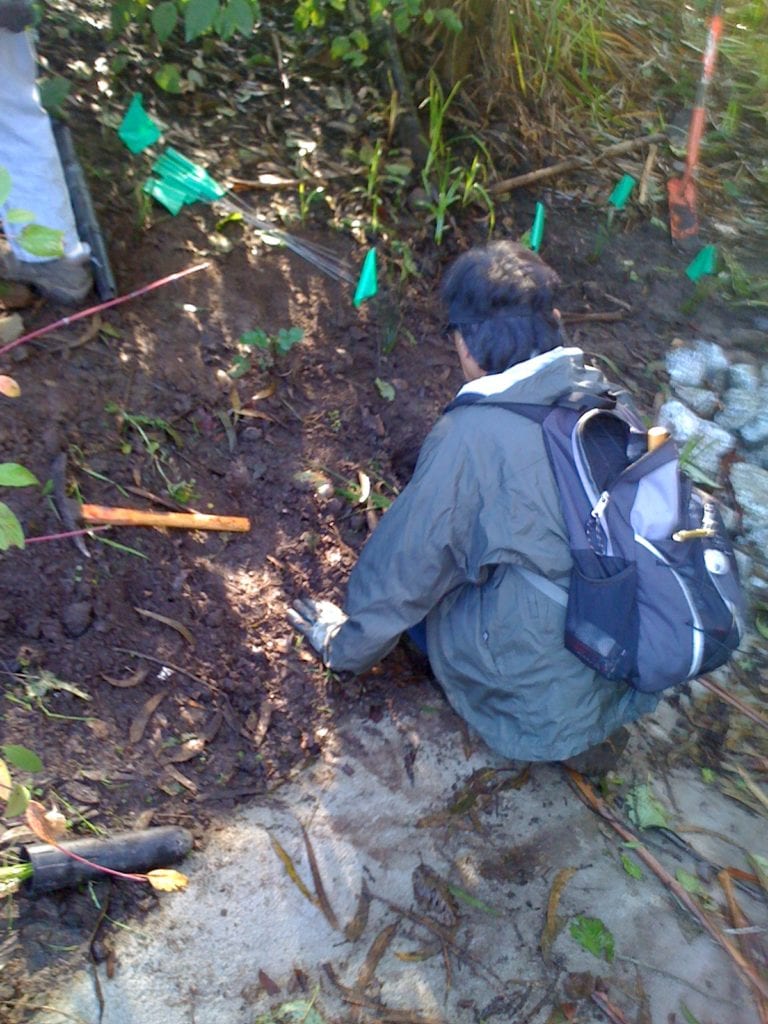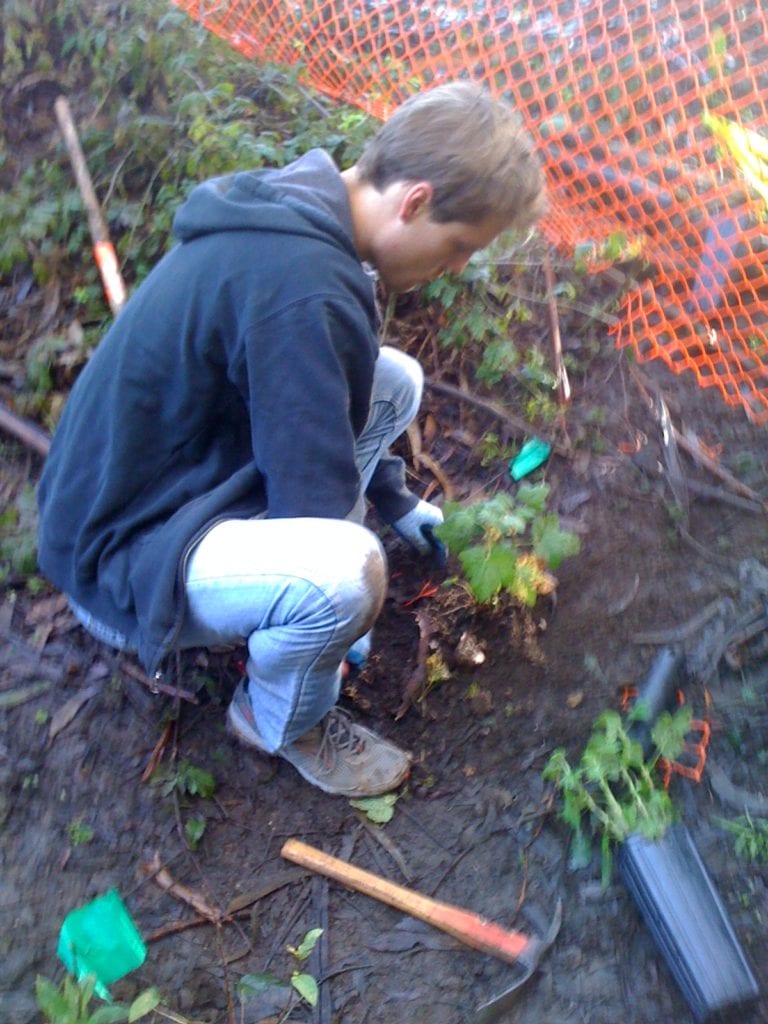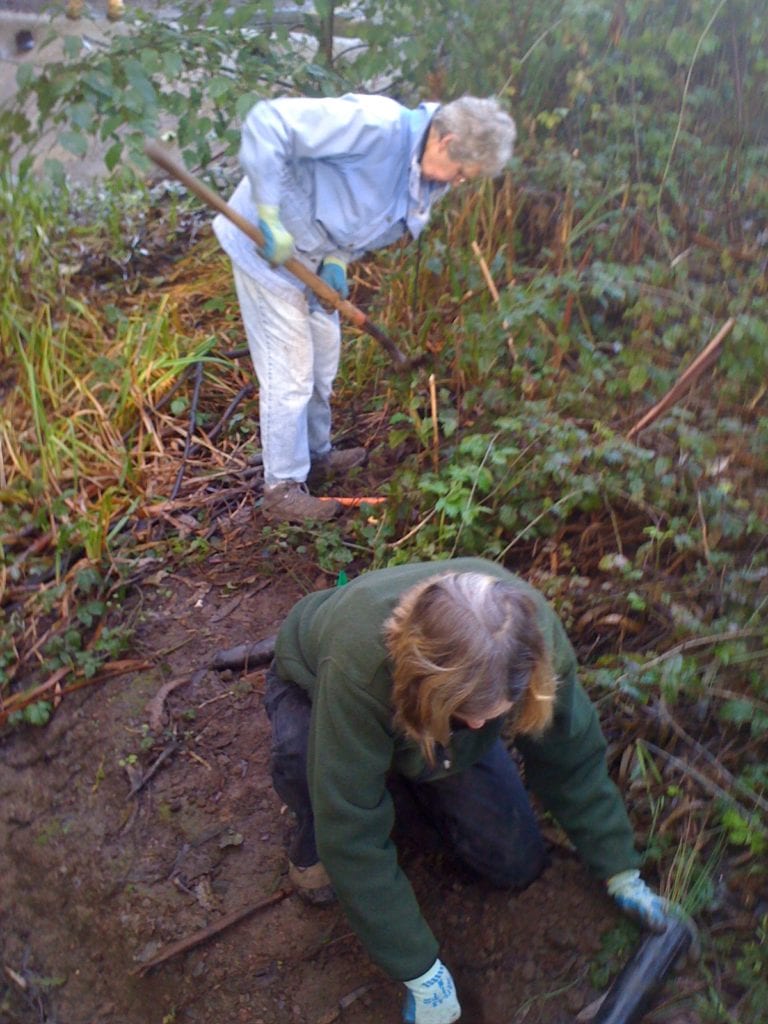
By Murray Schneider
On December 12 six Friends of Glen Canyon Park volunteers turned their green thumbs to planting dozens of California native plants along Islais Creek as the creek, swollen after days of rain, disappeared into a culvert destined to empty into the Bay not far from AT&T Park.
The volunteers worked at the Levi site, so named because the Levi Strauss Company donated money to purchase scores of native plants, which the Recreation and Park Department’s Natural Areas Program believe have a salutary impact on the canyon’s natural habitat.
“Besides beautifying the area,” said Connie Chan, Rec and Park’s Deputy Director of Public Affairs, “the flowering currents and other native species help control erosion and provides important foraging habitat and shelter for canyon critters.”
As if on cue, Steve Uchida, a retired postal worker who lives on Monterey Boulevard, put aside a Lady Fern and walked to the creek’s edge. Kneeling, he scanned a set of fresh animal footprints, which inched their way along the moving stream. A moment before a NAP manager indicated the prints belonged to a raccoon. The footprints angled along the creek bed, making imprints in the muddy ground while the water continued running only centimeters away. Clearly, the raccoon had quenched its thirst before dawn.

The volunteers continued planting flowering current, California rose and juncas on both sides of a concrete dam, recently repaired under NAP supervision. The asphalt dam had been crumbling and only recently had been put to rights. Now strengthened, it stopped sediment. It had been fashioned with drainage holes allowing ribbons of water to weep through the construction material.
“The sediment basin needed repair. It wasn’t functioning as designed,” said Connie Chan, charged with the role of putting a public face on the Natural Areas Program, whose mission is to protect the biodiversity of 32-natural open spaces in the City. “As a result, sediment built up at the entrance to the storm system culvert.”
“It’s important to prevent the storm system from overflowing,” Chan continued, “Otherwise the sediment from the creek ends up in the Bay.”
The volunteers continued working, digging 18-inch long holes with trowels, shovels and mattocks. Closer to the creek, the mud morphed into suction cups of dark goo and sucked at their boots and sneakers in messy globules.
“We’ll place the twinberry up there,” said Jenny Sotelo, a NAP manager, pointing up the slope that dead ended at Alms Road and was protected by orange plastic fencing. Two volunteers navigated the incline, dodging green flags, careful not to disturb earlier plantings. Twinberry is a magnet for pollinators such as butterflies and is thus highly prized by the NAP.

Kay Westerberg, a retired San Francisco Unified School District teacher who lives on Chenery Street, accompanied her son Zack Clark, a first-time volunteer. Zack held an oblong green canister, massaging a juncas plant from it before gingerly placing it in the hole he’d just dug. After he positioned the spaghetti-tangled rush, he shoveled the soggy soil back into the earthen cavity, careful not to upset the plant’s delicate root system. He patted the ooze with rubber-gloved hands. Zack just graduated from Lawrence University, a small liberal arts college in Appleton, Wisconsin. He plans to volunteer as a tutor at Balboa High School while looking for a job. Zack, an English literature major, joined his mother for a morning of Natural Areas Program Horticulture 101.

Jenny Sotelo surveyed the efforts, paying particular attention to compromised fencing and the network of paralleling coirs that descended to the creek. The organic coirs looked like enlarged bedrolls, the sort of bedrolls Wyoming or Montana cowpokes tie behind their saddles when they herd cattle on open range.
Rolls of brown coir, extracted from coconut husks, are used by the Natural Areas Program for erosion control and can be commonly seen along California riverbanks and hillsides. The NAP, practitioners of integrated pest management, recommends coir since earth-friendly coir is free of fungal spores and produces results without environmental degradation, useful in the Levi site in deterring snails from introduced plantings.
“We don’t want this area to become denuded,” Sotelo said. “And it shouldn’t be a social trail either.”
The volunteers began to trickle back to Alms Road, straddling a segment of sagging fencing. A volunteer tugged at crinkled green flags that signaled previous plantings, now healthy and thriving with abundant monkey flower. He tossed the flags in an ash can beneath a giant eucalyptus tree that annually houses a nesting mother Great Horned Owl.
With a little less than an hour to go before the weekly work party ended, the group fanned out along Alms Road, needing little direction from its NAP supervisors as to what needed to be done next.
Mary Huiznga, who lives on Laidley Street, searched out tendrils of Cape ivy and stalks of Himalayan blackberry and was soon swallowed among Arroyo willow that jigsawed along the fire path. Shortly, Jean Conner, who lives on Sussex Street, joined her and was also lost to sight in a labyrinth of lichen-crusted branches that circled back toward the creek.
Kay Westerberg and her son walked by Glenridge Co-op Nursery School and then up and along the canyon’s eastern slope, searching for radish to unearth, while Steve Uchida scaled the narrow path above the road, occasionally making way for dog walkers, and looked for early infestations of thistle. Crags of chert shadowed him and he, too, was soon lost to view.
An hour passed before the volunteers reassembled and returned their tools to the Rec and Park truck’s flatbed.
“We found some mustard,” said Kay Westerberg.
An experienced crew that had been there and done that and had long worked well with one another nodded knowingly. Westerberg’s declaration spelled plenty of spring- time weeding.
The group began to disband after sampling snacks of cookies and water.
Uchida headed up the hill toward the Sussex Street steps; Conner and Huizinga strolled past the Rec Center gym and turned right on Elk Street.
Tall and angular, Zack Clark placed an affectionate hand on his mother’s shoulder. They walked together along Alms Road, soon to be altered now that the Glen Canyon Renovation Project faces one last eleventh hour appeal, then past where two diseased Monterey Pines fell on October 1.
The long awaited community-based project, which envisions a sculpted park entrance with a walkway replete with new trees and additional California native plants will mean plenty of future work for the Friends of Glen Canyon Park, possibly even for neophyte Zack Clark. He’d be welcomed back to his neighborhood’s 70-acre green house for a graduate seminar in the finer points of riparian native plant and shrub ecology.
If neighbors would like to volunteer in Glen Canyon Park, they can contact Natural Areas Program volunteer coordinator Joe Grey at joe.grey@sfgov.org (415-831-6328) or Jean Conner of Friends of Glen Canyon Park at 415-584-8576